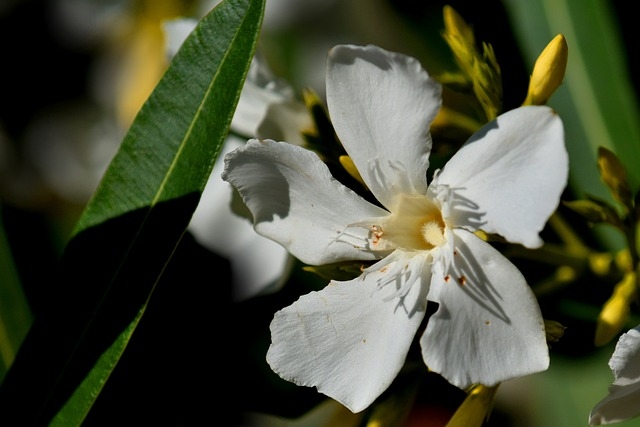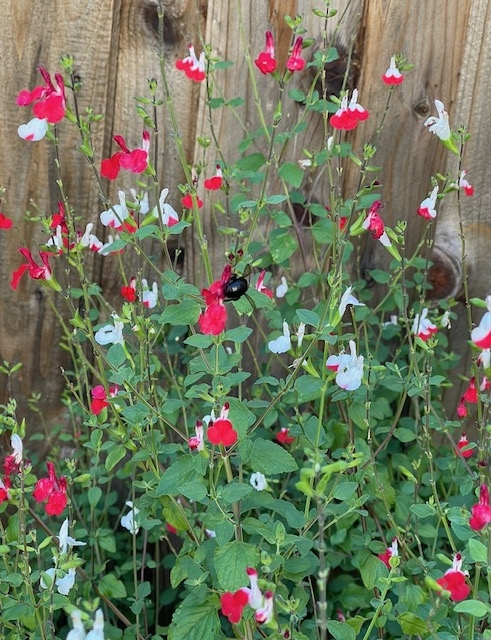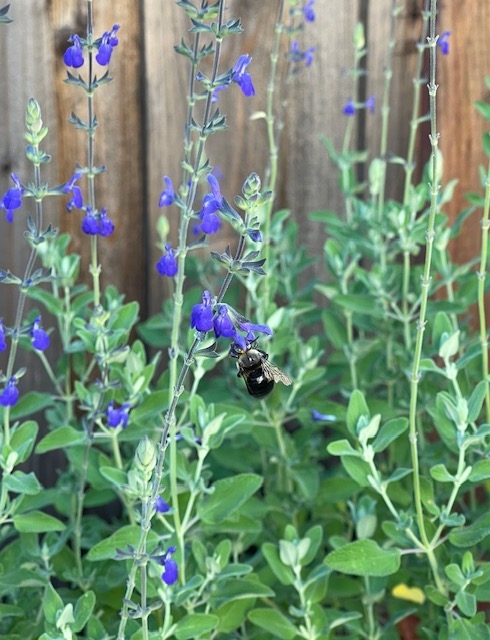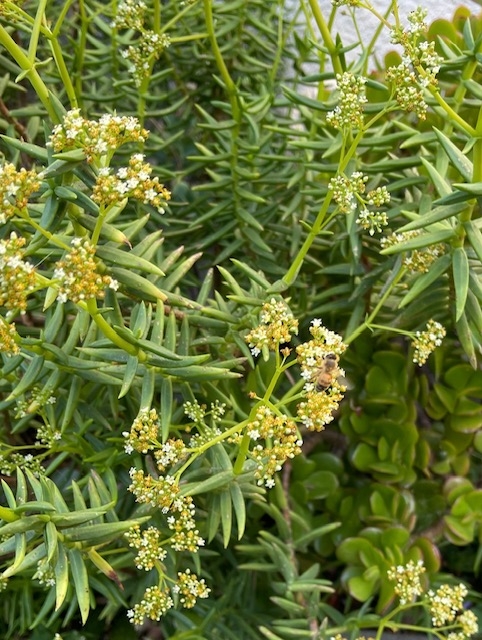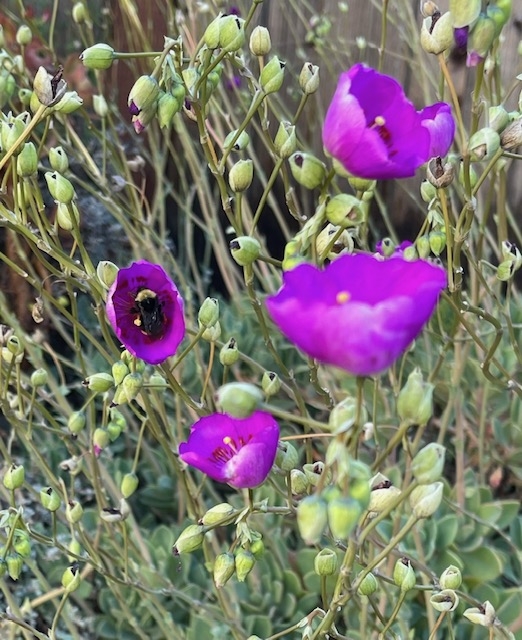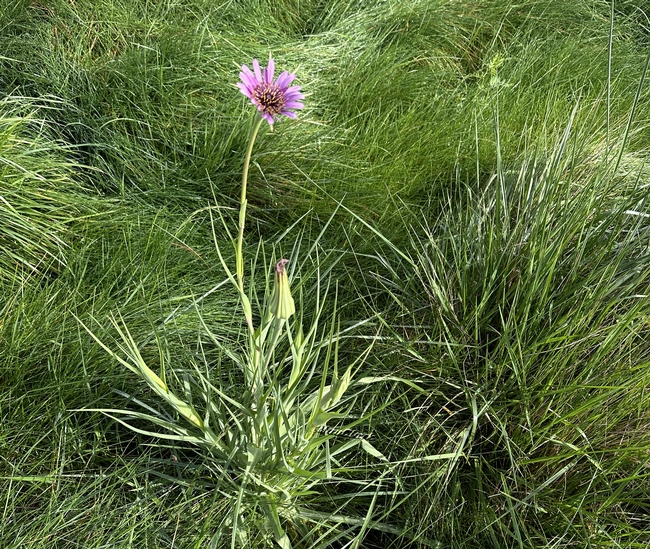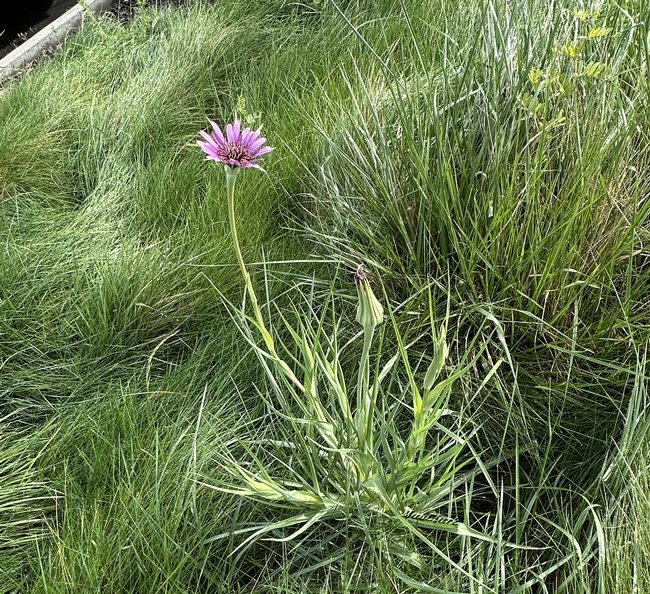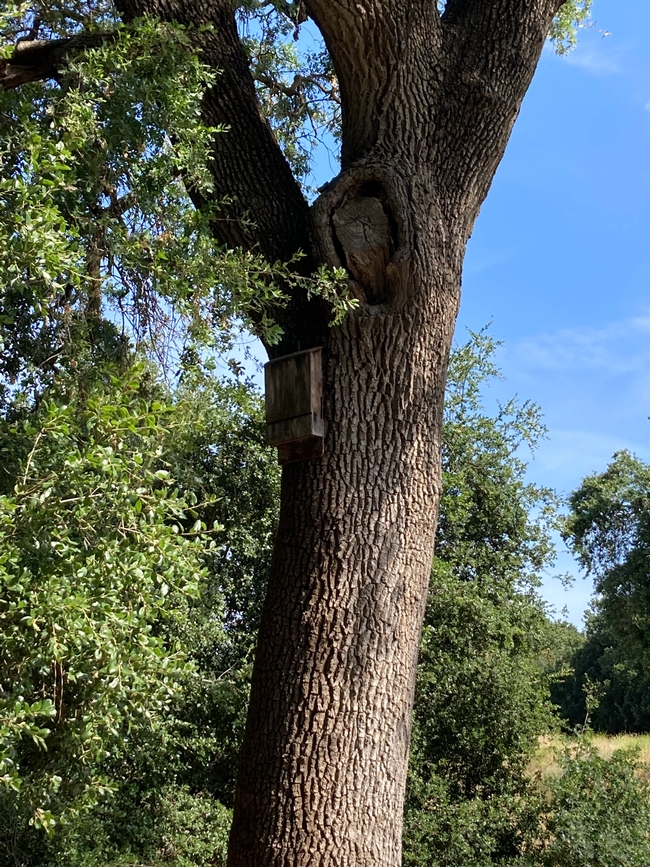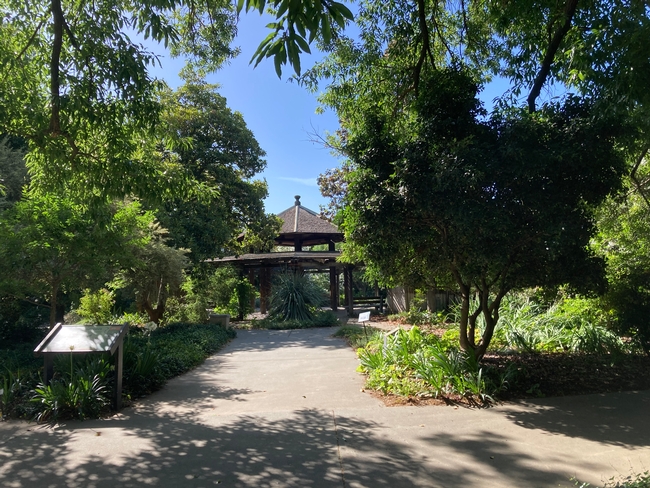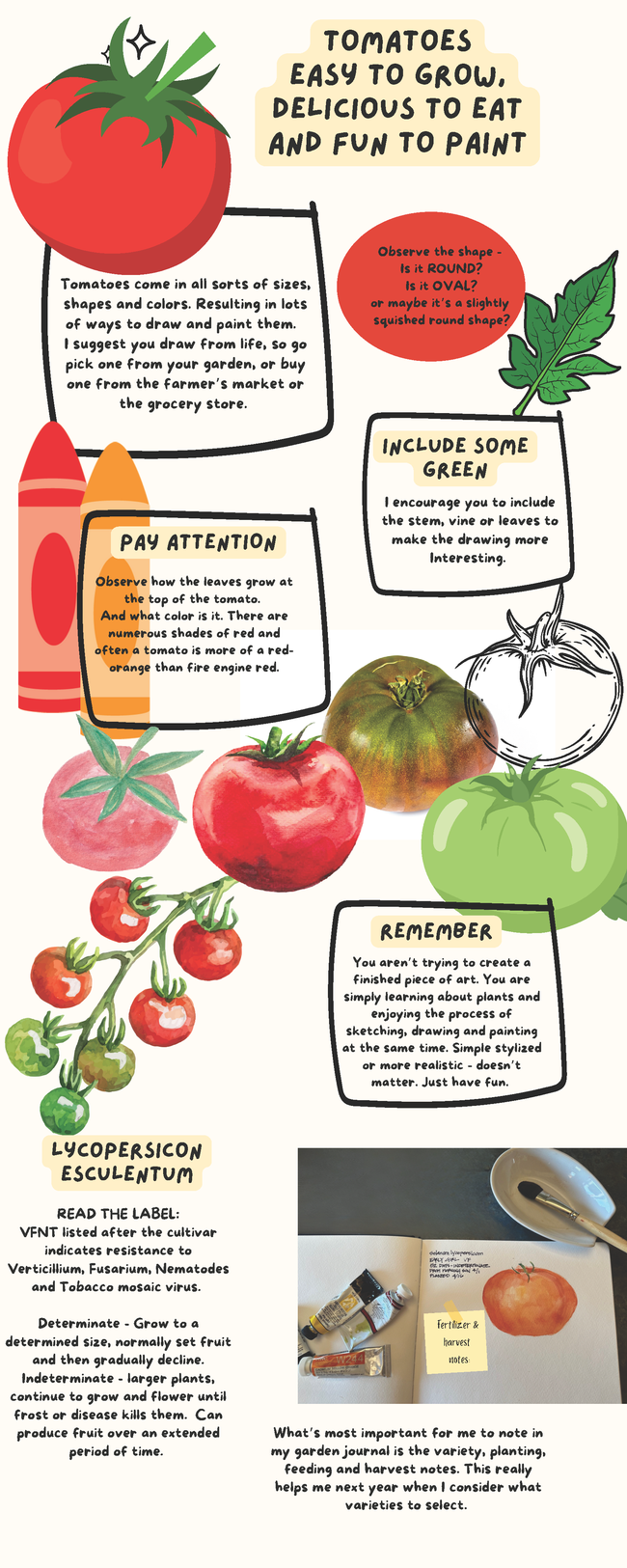- Author: Cindy Yee
It's going to be a sizzling 100°F day today, so I'm outside watering the yard at 7:30 am and notice all the bees also making an early start. Here are some of the bee magnets in my backyard.
Salvia microphylla' Hot Lips' is a perennial favorite. It is not a native, but you wouldn't know it from the number of carpenter bees kissing Hot Lips.
I love the brilliant blue of this sapphire sage. I am always happy to provide the carpenters with a welcome distraction. Otherwise, they would be diligently boring into my hole-studded wood pergola!
Right now, this Crassula tetragona is covered in clusters of white blossoms, and bees are humming around it. It is extremely low maintenance and does spread.
Calandrina spectabilis' stunning magenta flowers make perfect little bowls for visitors to rest and savor the pollen. In May,Calandrina provided a glorious riot of color.
Lastly, Salvia 'Pozo Blue' would be a strong contender in a pollinator popularity contest. Several bees are navigating its many blue-violet blossoms (there is no picture of a bee because it's up high in the retaining wall). Being a native, Pozo Blue does not need much water.
Keep up the good work, bees. Buzz on! Cheers!
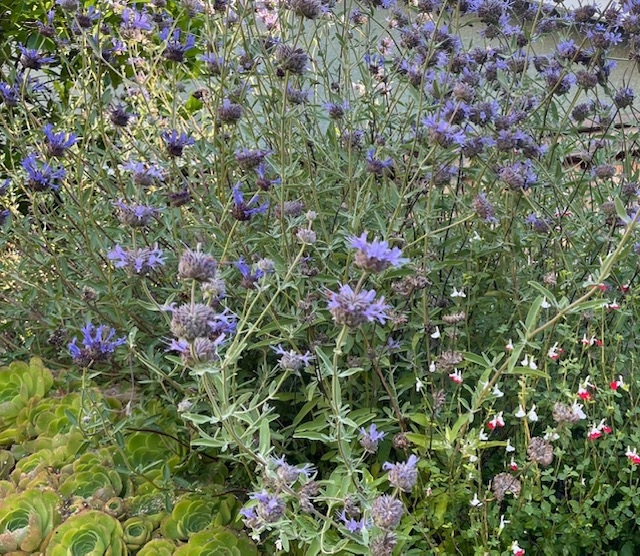
- Author: Maureen Clark
Now is the time I dig out the Purple Goat's Beard. The ground is still wet, and the leaves are not too large yet. The Salsify plant somehow made it into my front yard garden. I originally thought it was lovely because I knew this plant was edible. After it bloomed, I knew that it was a terrific reseeding plant and not my garden. It initially came in on the wind from the puffball seed heads, which can travel hundreds of feet.
Most people consider this edible, biennial plant a broadleaf weed. But some foragers harvest wild plants. They eat them raw or make dishes using the roots or leaves. Other people grow large areas of these plants and cultivate them. NOTE: Please do not eat anything you haven't been identified by an expert.
This plant is part of the Asteraceae family and contains three Tragopogon species.
T. dubius, T. porrifolius and T. pratensis. ‘Tragos' means goat in Greek and ‘pogon' means beard. This plant originates from Eurasia and Northern Africa.
It has several common names: Purple Goat's Beard, because of the longer bracts that stick out along the flower petals and look like a goat's beard with purple petals; Oyster plant, because its roots are supposed to taste like oysters; Noon flower, because the blossoms open early at dawn and close at noon; Western Salsify, which has pale yellow flowers; and Meadow Salsify, which has bright yellow flowers.
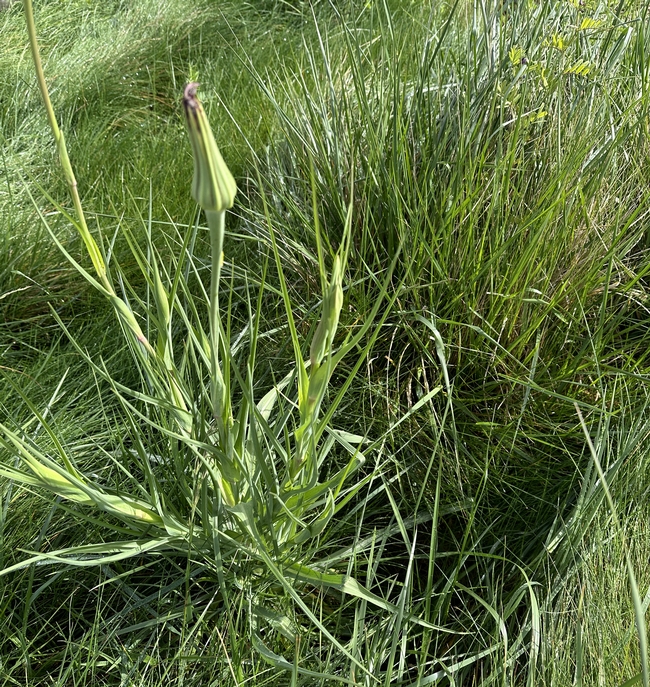
Salsify starts with a basal rosette of gray-green, grass-like foliage. It has hollow, milky stems and a deep, 1 to 3-foot tap root. It will develop 5 to 6 flowers per plant and grow 2 to 4 feet tall.
The flower arrangement is solitary with an upright habit. The 3 to 4-inch, daisy-like flowers emerge from large, long, narrow pointed buds. Interestingly, these Asteraceae flowers do not have a center disk and only have ray florets. The Florets sit on top of a series of pointed bracts, which encase the flower and from the seed head when closed. So next time you find the Tragopogon plant in bloom, look closely at how the bracts emerge. Do they extend past the petals? Then it is the T. dubius species. If the bracts are equal to the petals in length, then it is the. pratensis. If the plant has a purple flower it is Tragopogon porrifolius.
- Author: Michelle Davis
June is Pollinator Month, and Pollinator Week is June 17th – 23rd. Most people can name pollinators- bees, butterflies, moths, and birds- but they don't always remember bats. Bats pollinate at night, which may be why they don't always get credit for their work. We don't usually see them in action. Bats search for big white or pale, funnel or tube-shaped flowers with strong fruity fragrances. They carry the pollen from the blooms on their fur and faces. These nectar-filled flowers belong to more than 300 food-producing plants and a plethora of evening bloomers. Most of the food-bearing plants are grown in desert or tropical regions and include bananas, guavas,mangos, cacao, dates, and cashews, and around here include figs and peaches. Flowers include evening primrose,nicotiana, datura, yucca, and French marigolds. For more examples of moon garden flowers, visit the Carolee Shields White Flower Garden and Gazebo at UC Davis Arboretum located at the southwest end of the arboretum near the Veterinary Medical Teaching Hospital. Not far from the moon garden is a bat box attached way up in a tree near the equestrian area.
If you drive across the Yolo Causeway at dusk on a summer night, or take in a Bat Talk and Walk with Corky Quirk, NorCal Bats founder, you may get to see a lot of these amazing mammals, when approximately 250,000 to 300,000 Mexican free-tailed bats stream from under the causeway, their summer home and the site where they come to give birth. Their diet includes armyworms, cutworms, moths, and other agricultural pests. They will soar two miles up to capture their prey and patrol up to 30 miles each night and eat about one-half their weight in pests each night. Pregnant and nursing bats can ingest their own weight in moths each night! One bat can consume 600 mosquitoes per hour. The area these bats, and also a lesser number of big brown and Yuma bats, cover is a fair amount of our country's sushi rice basket and also includes several fruit and nut orchards.
Bracken Cave Preserve near San Antonio, Texas has a spectacular show from March to October of 20,000,000 pregnant or nursing Mexican free-tailed bats creating what looks like a tornado on meteorology screens as they exit the cave at dusk to search for food for themselves and their pups. Each female bat gives birth to one pup usually in late June. That pup is born naked. Warmth is crucial for survival, so the pups are packed together as much as 400 pups per square foot. Mom recognizes her pup by its scent, vocalizations and by her own memory of where it is in the cave, and she returns to it several times during the day and a couple of times per night to nurse and feed it.
If you want to try to attract bats to your vegetation, the ideal bat house is made of rot-resistant, non-pressure-treated wood like white oak or cedar with 4 chambers inside, painted with oil-free, dark-colored paint on the inside, well-caulked on the outside to stop drafts and mounted 10-20 feet off the ground, ideally away from trees to keep predators out. The boards for the chambers should be roughened up first. This allows the bats to climb from the bottom of the house upward. Poles or buildings are better options for mounting. The bat house needs to get at least 6 hours of direct sun exposure every day to keep the young warm. (The sun-blasted asphalt on the Yolo Causeway is what keeps the bat babies incubated in the expansion joints under the bridge.) A water-source less than 200 feet from the bat house is preferred, but it doesn't have to be a lake or even a pond. A cattle trough filled with water will do. If you have ever hiked at Lagoon Valley near dusk during the summer, you might have seen bats zooming and dipping over the troughs on the hills grabbing a quick drink.
Bats are sometimes feared in our culture, but China and other Asian nations consider them good fortune. If you look closely at museum art from that part of the world, it is not unusual to find bat depictions. Bats make up nearly a quarter of all mammals on Earth, and they are amazing workers and pollinators, too!
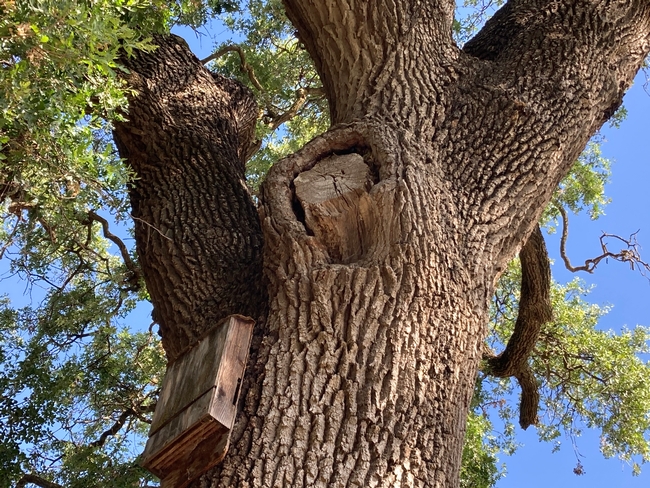
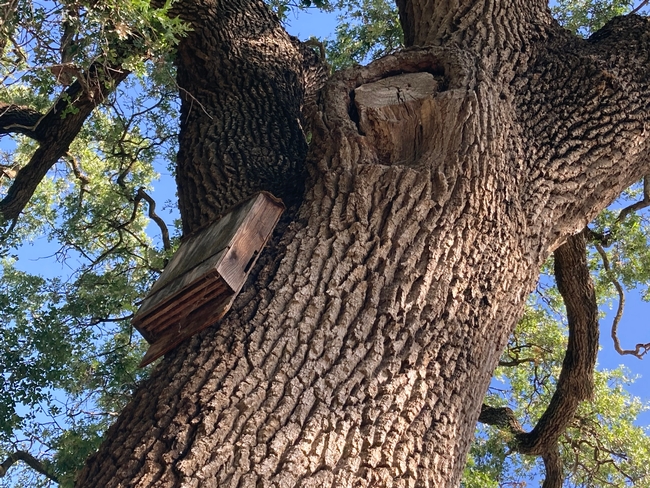
- Author: Dilcie Paschall
Oleander, also known as Nerium oleander, is a fascinating plant that often sparks curiosity and debate. Is it a toxic weed or a beautiful shrub?
Oleander is celebrated for its stunning flowers, which come in a variety of colors such as pink, white, red, and yellow. Its evergreen leaves and ability to thrive in hot, dry climates make it a favorite among gardeners, especially in regions with limited water. This hardy plant can grow quickly and form dense hedges, providing both beauty and privacy in your yard. My oleander is quite large and has beautiful white flowers that are abundant right now.
However, it's important to know that oleander is highly toxic. All parts of the plant contain substances that can be harmful if ingested. Symptoms of oleander poisoning include nausea, vomiting, and even serious heart issues. Because of this, some people might think of oleander as a "toxic weed," especially in places where it grows uncontrollably and poses a risk to pets.
Whether oleander is considered a weed or a shrub often depends on where it is growing. In some areas, oleander spreads easily and can take over natural spaces, making it seem more like a troublesome weed. But in a well-maintained garden, where its growth is monitored, oleander can be a delightful addition that brings vibrant color and greenery without much hassle. However, if you have pets or small children, oleander is surely a weed in your book and removal might be the best way to go. Good luck with removal efforts. Mine is reluctant to leave in spite of my efforts when my children were small and curious. They've since grown up and now I just keep an eye on the dogs. They seem to know better than to bother it.
Oleander can be seen as both a toxic weed and a cherished shrub. Its toxic nature means we need to handle it with care, but its resilience and beauty make it a popular choice for many gardeners. With proper knowledge and responsible gardening, you can enjoy the stunning oleander safely. This remarkable plant truly offers the best of both worlds—just remember to treat it with the respect it deserves!
